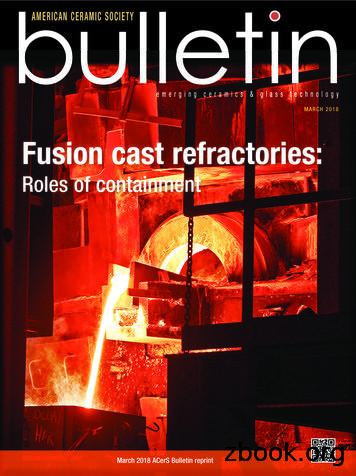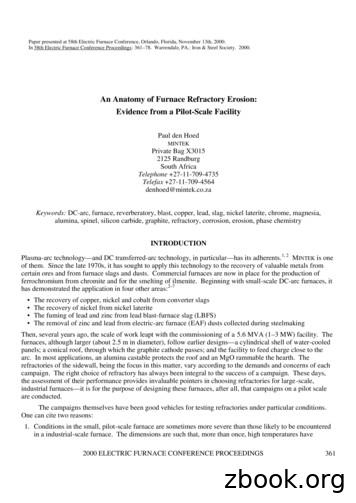IN REFRACTORY LININGS: “IT’S WHAT’S INSIDE THAT
IN REFRACTORY LININGS: “IT’S WHAT’S INSIDETHAT COUNTS”Galveston, TXMay 3‐6, 20111IN REFRACTORY LINING SYSTEMS It’s what’s inside that counts If it’s not good inside, it’s not good! It doesn’t matter how well a lining is installed It doesn’t matter how good the design is It doesn’t matter how good the materials are The only thing that matters is what’s inside – if it isn’t goodinside, it isn’t good, and the war has been lost2
DOES THIS LOOK FAMILIAR?3WHAT ARE THE ISSUES THAT LEAD TO POOR REFRACTORYQUALITY? New refractory material can be bad refractory material Theh refractoryfinstallerill may not beb competent to installill theh refractoryfsystem as specified Good anchor installers can do inferior work Installation specifications may be lacking in detail Installation procedures may be incomplete incorrect, or non‐existent The refractory design may be impractical or impossible to install4
WHAT ARE THE IMPLICATIONS OF POOR REFRACTORYQUALITY? Reduced refractory life: Inferior refractory linings will be replacedsooner than will high quality systems Increased maintenance that can lead to increased downtime Greater possibility of refractory failure resulting in emergencyoutage The cost of inferior refractory systems can be huge Kind of like the old Fram oil filter commercial: You can pay now orpay later5HOW ARE THESE QUALITY PROBLEMS AVOIDED? Refractory Quality Control– Refractory material prepre‐installationinstallation certification by laboratorytesting– Refractory installer pre‐installation certification– Laboratory testing of field production samples– Continuous inspection during refractory lining installation– Approved refractory installer installation procedure6
REFRACTORY MATERIAL CERTIFICATIONWHY TEST? Being new does not necessarily make a refractory material good Certification performed prior to refractory shipment from themanufacturer Acceptable physical properties are agreed on prior to placing anyorder Making sure that the physical properties of the materials shipped areas specified and agreed upon It’s what’s on the wall that counts7REFRACTORY MATERIALDATASHEETSTypical Refractory Datasheet8
REFRACTORY MATERIALDATASHEETS The Disclaimer– Refractory material manufacturers attach a disclaimer to theiradvertised data– Interpretation: We don’t guarantee you will get what we got Avoiding the Disclaimer– Determine ahead of time what properties are required for thework– Look at competitive datasheets– If the selected refractory material manufacturer cannot standbehind the properties required, buy somewhere else9REFRACTORY MATERIAL TESTINGWHICH TESTS AND WHY Density or Bulk Density– Weight per unit volume of the refractory concrete– A reflectionfl i off insulatingi l i abilitybili Compressive (Cold Crushing) Strength– The ultimate strength of the material in compression Permanent Linear Change– The percent change in length from the dried to the fired state Abrasion Resistance– A guide to the expected resistance to abrasion in service How valid is the test data/how does it relate to reality?– Room temperature tests/ why is it reliable?– Easy and inexpensive tests to perform– Red flag tests10
REFRACTORY MATERIAL TESTINGCompressionModulus of RuptureAbrasion ResistanceMeasurementsTypical Laboratory Specimens11INSTALLER CERTIFICATION Not every refractory installer is able to do the work as specifiedeven if he has done the same work in the past Installer demonstrates ability to do the work in advance of theactual refractory installation The installer uses Owner specifications and agreed‐uponwritten installation procedures The adequacy of installer personnel is confirmed The adequacy of installer equipment is confirmed12
INSTALLER CERTIFICATIONHOW IS IT DONE?Vibration CastingPneumatic RammingPneumatic Gunning13FIELD PRODUCTION TESTINGWHY TEST? A certified installer can do bad work Field sampling and testing keeps the installer alert to quality A record is provided of what’s on the wall, and it’s what’s on thewall that counts In event of failure, the owner has the knowledge to make aninformed engineering decision regarding the problem If testing is not faithfully performed, quality suffers and costgoes up14
REFRACTORY INSPECTIONWHY INSPECT? To confirm that the agreed upon specifications and procedures have beenfollowed To provide a documented record of what has been installed on the wall,where it counts To provide information from which the owner can make educatedrefractory engineering decisions To assist the owner in making quality assessments of new or existingrefractory lining systems Most importantly, to make certain that all refractory installations are of thebest reasonable quality, that good service should be expected.15TYPICAL AREAS OF REFRACTORY INSPECTION Review material test reports Monitor site storage of refractory material Initial inspection of existing systems with repairrecommendations Assure steel surfaces are properly repaired for refractoryinstallation Verify refractory anchoring systems are as specified andproperly installed16
TYPICAL AREAS OF REFRACTORY INSPECTIONRefractory Anchor InspectionSurface Preparation17TYPICAL AREAS OF REFRACTORY INSPECTIONRefractory Installation by Pneumatic GunningRefractory Installation by Pneumatic Ramming18
TYPICAL AREAS OF REFRACTORY INSPECTIONRefractory Installation by Vibration CastingThermal Drying19TYPICAL AREAS OF REFRACTORY INSPECTIONMaintaining Lining ThicknessVisual Inspection and Hammer Testing20
TYPICAL AREAS OF REFRACTORY INSPECTION Monitor all aspects of refractory preparation and installation:‐ Water content‐ Temperature control‐ Mixing time‐ Lining thickness‐ Joint construction‐ Form installation‐ Ambient curing procedures‐ Drying and firing‐ Visual inspection‐ Hammer testing21TYPICAL AREAS OF REFRACTORY INSPECTION22
TYPICAL AREAS OF REFRACTORY INSPECTION23HOW TO CONTACT USRobert J. Jenkins & Company906 Medical Center BlvdWebster, TX 77598Phone: 281‐332‐3566Ph281 332 3566Fax:281‐332‐3871Email Contact: rjenkins@rjjenkins.comWebsite: www.rjjenkins.com24
Reduced refractory life: Inferior refractory linings will be replaced sooner than will high quality systems Increased maintenance that can lead to increased downtime Greater possibility of refractory failure resulting in emergency outage The cost of
In refractory industries, they are used in steel ladle linings, high temperature bricks and glass tanks. Zircon is generally combined with other materials, including zircon flour, pre-fired zircon and bonding agents, to extend the ladle lining life up to 5-10 times that of alumina brick linings. 1.5. DOLOMITE AS A REFRACTORY
Mar 08, 2016 · Evolution of glass furnace refractory linings Toward the end of the 19th century, fireclay, a bond-ed alumina refractory, was the glass furnace refractory lining of choice. This progressed to a better quality of fireclay, and later, the refractory lining package included bonded silica brick,
Refractory Solutions for Aluminium Refractory Installation Refractory Services, as part of the Capital Refractories Ltd group, is here to offer full turnkey solutions for furnace refractory installations. Whatever the job, and whatever the location, or installation, we have a team of exper
The total cost of a refractory is the sum of the cost to purchase the refractory, install the refractory, and maintain the refractory. The patented refractory technology in the WAM AL family of products helps to inhibit the formation of corundum, which extends
Refractory gout is a rare form of severe gout. Both gout and refractory gout are very painful, but refractory gout more often leads to serious problems like permanent joint damage and trouble with moving and walking. Refractory gout may not go away with standard treatments. Other medicines may be needed. P
Nov 04, 2015 · constraints and economic drivers, oftentimes little consideration is given to furnace heat up rates that will prevent damage to the refractory linings. This has sometimes led to refractory failure before reaching normal operating conditions or premature de
The hot-face is at the refractory-slag interface and temperature drops across the refractory. This stands in contrast to the cup test, in which a crucible of the refractory, or a cavity drilled into a brick of the material, is filled with slag and heated in a furn
The API is most useful when there is a need to automate a well-defined workflow, such as repeating the same tasks to configure access control for new vRealize Operations Manager users. The API is also useful when performing queries on the vRealize Operations Manager data repository, such as retrieving data for particular assets in your virtual environment. In addition, you can use the API to .























